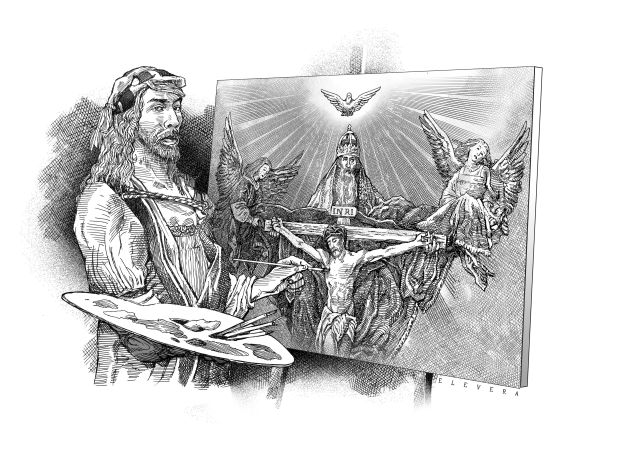
The classical representations of the Blessed Trinity almost always portray the Holy Spirit as a dove, just as at Christ’s Baptism. There were portrayals, however, when all three persons of the Blessed Trinity were in human form, likely because in Genesis the Lord came as three men to Abraham to announce that his wife Sarah, despite her advanced age, would bear a son.
In Dürer’s painting, just as in most other paintings of the Trinity, the Father is an elderly man with a white beard, no doubt inspired by Daniel, who writes about “the Ancient of Days” — “As I looked, thrones were placed and one that was ancient of days took his seat; his raiment was white as snow, and the hair of his head like pure wool; his throne was fiery flames, its wheels were burning fire.”
The scene in Dürer is that of the “Throne of Mercy,” a setting then popular in Christian art, which showed the Father supporting a cross with Christ on it, or holding a limp Christ in his arms, and the dove above or between them.
Dürer rendered the scene in 1511, in oil, on a poplar panel. The work hangs in the Kunsthistorisches Museum, Vienna, Austria. Matthäus Landauer, a rich businessman from Nuremberg, commissioned it as altarpiece for a chapel dedicated to the Blessed Trinity.
In the painting, the Father wears a crown and a green-lined golden overgarment held up by angels.
Arrayed around the Throne of Grace are the saints, the female saints on the left led by the Blessed Virgin Mary, and the male saints on the right together with John the Baptist. Below them are the holy men and women, headed by the pope, and the laymen, led by the Holy Roman Emperor.
Dürer has included his patron, Matthäus Landaurer, in the painting, as well as a self-portrait of himself, holding a cartouche, which contains his name and the year, 1511.
A landscape scene of dawn breaking upon a lake set among hills occupies the bottom.
Scholars claim that it was the Greek artists of the 11th century who began portraying the Triune God. At first, the Son was an infant sitting on the Father’s lap. Later, the adult Christ replaced the infant. But always a dove represented the Holy Spirit.
The Catechism of the Catholic Church declares that “[t]he mystery of the Most Holy Trinity is the central mystery of Christian faith and life . . . the mystery of God in himself.” It is, it adds, “the source of all the other mysteries of faith, the light that enlightens them.” “[T]he way and the means by which the one true God, Father, Son and Holy Spirit, reveals himself to men” is identical with “the whole history of salvation,” it says.
I find the elements of Dürer’s painting in the Millenium Jubilee Cross, which shows the Father holding the arms of the crucified Jesus, and the Holy Spirit as dove hovering above his head. Nothing quite depicts the history of salvation better than this, and pictorially renders this passage from John: “God loved the world so much that he gave his only Son, so that everyone who believes in him may not be lost but may have eternal life.”
This love is as baffling as the statement, God is one, but God is three. Fr. Robert Barron remarks that this is meant to confound us. He speaks of the incense that is used at the very sacred moments of the liturgy, to symbolize our prayers rising to God. He quotes Cardinal Ratzinger, “A purpose of the incensation is to get in your eyes.” It’s to block you, Barron says. “It’s meant to say, ‘don’t think you can see all that clearly what’s going on here. Don’t think for a moment that you’re in control of the situation. You’re not.’”
Barron adds, “Trinitarian language is a bit like that. It’s meant to be smoke in the eyes of the mind, so that we’re not tempted to say, ‘I fully understand God.’”
“Si comprehendis non est Deus,” declared St. Augustine — if you understand it, it is not God.
Clearly, when it comes to love or truth, God always is a step ahead.
Disclaimer: The comments uploaded on this site do not necessarily represent or reflect the views of management and owner of Cebudailynews. We reserve the right to exclude comments that we deem to be inconsistent with our editorial standards.
